5 Oregon Coast Beaches With Treasures Thousands of Years Old
Published 02/03/2015
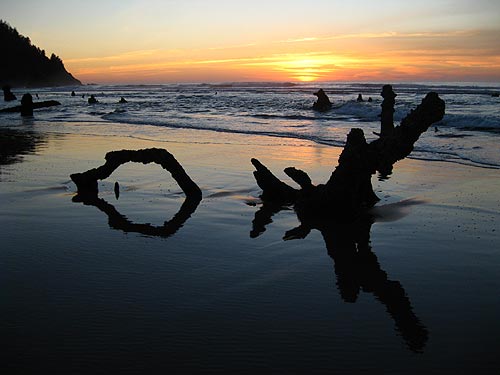
(Oregon Coast) – Almost every winter in the 90's and early 2000's, some incredible treasures would come to light. Sand levels would drop so low because of storm erosion that ancient forests – nearly petrified by their millennia beneath the beach – would emerge. (Above: Neskowin's ghost forest).
These are the Oregon coast Ghost Forests – so named for their slightly spooky appearance but also for the fact they predate white settlers by perhaps 4,000 years or more.
The trend seems to dissipating in the last few years. Or at least things are swinging the other way for awhile, and this year the ghost forests don't appear to be popping up. But that doesn't mean you shouldn't look out for them. If there have been some sizable storms lately, it's a good time to double check. Indeed, in some winter conditions, sand levels can change three feet or more in a single day
Some 45 places along the Oregon coast can show these oddities. You can see all of these here at the Ghost Forest Guide, and why they exist. There is also more on that at the bottom of this article. But here are five such amazing places to keep an eye on.
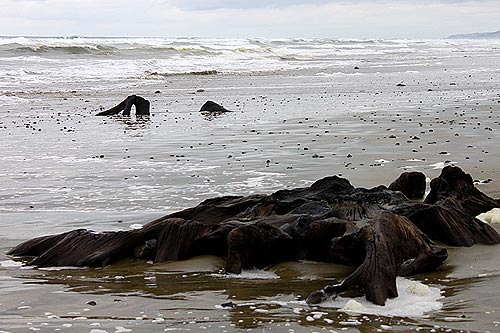
Seal Rock. Look for Curtis St., just a tad north of the bulk of Seal Rock. These weird ones have that sort of octopus shape typical of those specimens that are mere root systems. Sometimes they are twisted log-like shapes as well.
These kinds of stumps – like the ones at Moolack Beach at Newport – look this way because early European pioneers to the area sawed them off for their wood needs when they discovered them.
Scientists say these ones are about 4,000 years old.
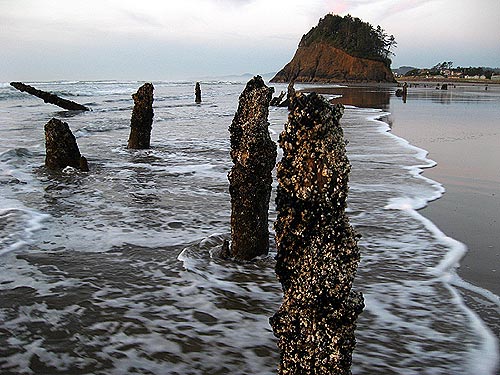
Neskowin. The only year-round stumps visible, you have to walk through a sometimes uncomfortably wild creek to get to them. But they are worth it. The Neskowin ghost forest is sometimes covered up in summer during high sand level events, however.
These are about 1,000 to 2,000 years old, according to carbon dating. They look like old pilings from some manmade pier at first, and are usually covered in barnacles from constant exposure to the sea. Out of most of the ghost forests along the entire coast, this is the largest of them and the ones that have retained a shape closest to that of a tree.
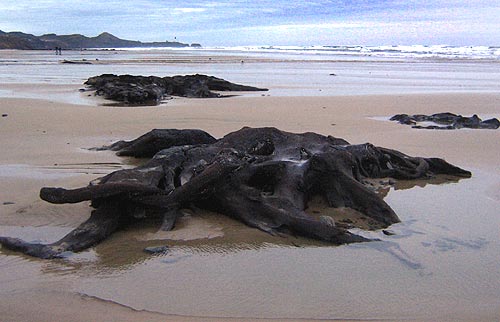
Moolack Beach, just north of Newport.
This group can be some of the most fascinating of the bunch, even though they too were sheared off into mere root system blobs over a century ago. They are massive and particularly craggy.
This group of ghost forest stumps is about 4,000 years old, say Oregon coast geologists.
Moolack Beach is also an excellent agate area.
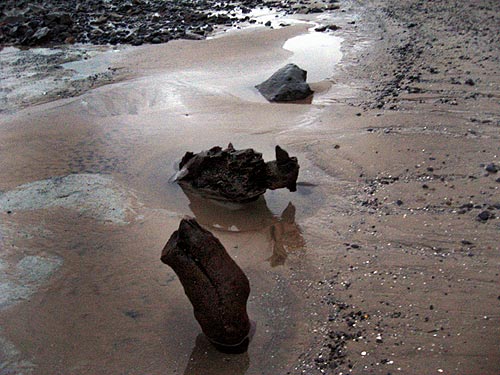
Arch Cape – Hug Point. Just south of Cannon Beach, this area can yield some of the most spectacular specimens – certainly the most eerie of the bunch.
If sand levels do get low enough around here to reveal the ghost forests, they also show off other bizarre geologic objects known as red towers. These are chunks of sand and iron that have solidified beneath the sand into surreal, Dr. Suess-like shapes. But once the red towers are exposed they quickly crumble.
The ghost forest stumps in this part of the north Oregon coast are smaller and a bit more twisted, but they tend to regain their tree-like shape. They appear to be about 4,000 years old.
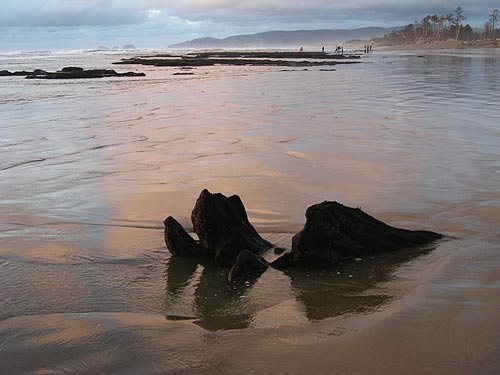
Cape Lookout State Park. More rarely seen than others, when this ghost forest pops up it is engaging. They are also probably the youngest of the group, likely around 1,000 years old.
What created the ghost forests? The short answer is either a massive earthquake dropped them below sea level suddenly or the landscape simply changed over a few decades. Whatever happened initially, the end result was they were covered up by sand for thousands of years, which cut off the exposure to oxygen and thus the usual decay of organic matter.
More About Oregon Coast hotels, lodging.....
More About Oregon Coast Restaurants, Dining.....
LATEST Related Oregon Coast Articles
Likely just before dawn best hour but peak happens during daylight. Weather
Dark Sky Week is Prime Along Oregon Coast: Where and Where Not to Go
General guide to dark sky viewing from south to north coast. Astronomy
Sizable Price Drop, Deals in Lincoln City During Quiet of April on Central Or...
20 perc off at A1 Vacation Rentals across its roster, including Gleneden Beach. Lincoln City specials
Upcoming S. Oregon Coast Events Include Gem Show, History: Coos Bay, Bandon
May 6 talk at Coos History Museum, Mayfly Fest May 17, Bandon Rock / Gem Show June 7,8
Washington Coast Cleanup on April 19 - Coinciding with Oregon Coast's SOLVE E...
From the Puget Sound to Long Beach, alongside Oregon's cleanup. Washington coast events, Seaside events
Astoria's Riverwalk Gets New Lighting, More N. Oregon Coast Roadwork
Delays coming this summer, but the riverwalk has a new look. Seaside, Cannn Beach
April Gets Even Cheaper Midweek at Depoe Bay, Lincoln City: Oregon Coast Deals
Off-season rates plus more at Keystone Vacation Rentals. Depoe Bay lodging specials, Lincoln City hotel reviews, Newport hotel reviews
Washington Coast Begins Week of Clam Digs, April 12 Through 18
Long Beach, Twin Harbors, Mocrocks and Copalis at different times. Washington coast events
Back to Oregon Coast
Contact Advertise on BeachConnection.net
All Content, unless otherwise attributed, copyright BeachConnection.net Unauthorized use or publication is not permitted











































